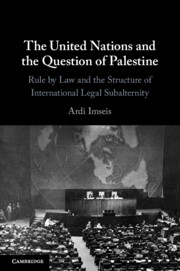 The United Nations and the Question of Palestine
The United Nations and the Question of Palestine Published online by Cambridge University Press: 16 November 2023
This chapter revisits UN General Assembly resolution 181(II) recommending the partition of Palestine. It undertakes critical international legal analysis of the resolution with reference to the work of the United Nations Special Committee on Palestine whose report formed the basis of the resolution. Contrary to the traditional historiography, this chapter posits that the resolution was neither procedurally ultra vires the General Assembly, nor were its terms substantively consistent with prevailing international law as regards self-determination of peoples. Set against the larger context of the international legal status of Palestine from WWI to the end of the British Mandate, this chapter argues that resolution 181(II) was the opening act in the reification of Palestine’s legal subalternity within the newly minted UN system. It demonstrates that the resolution was an embodiment, in legal terms, of the lingering tension between the rule by law of late-European empire and the ostensible rule of law of the post-WWII era. It also shows that the resolution helped hasten the dissolution of Palestine and the dispersal of its people, the consequences of which remain with us today.
To save this book to your Kindle, first ensure [email protected] is added to your Approved Personal Document E-mail List under your Personal Document Settings on the Manage Your Content and Devices page of your Amazon account. Then enter the ‘name’ part of your Kindle email address below. Find out more about saving to your Kindle.
Note you can select to save to either the @free.kindle.com or @kindle.com variations. ‘@free.kindle.com’ emails are free but can only be saved to your device when it is connected to wi-fi. ‘@kindle.com’ emails can be delivered even when you are not connected to wi-fi, but note that service fees apply.
Find out more about the Kindle Personal Document Service.
To save content items to your account, please confirm that you agree to abide by our usage policies. If this is the first time you use this feature, you will be asked to authorise Cambridge Core to connect with your account. Find out more about saving content to Dropbox.
To save content items to your account, please confirm that you agree to abide by our usage policies. If this is the first time you use this feature, you will be asked to authorise Cambridge Core to connect with your account. Find out more about saving content to Google Drive.